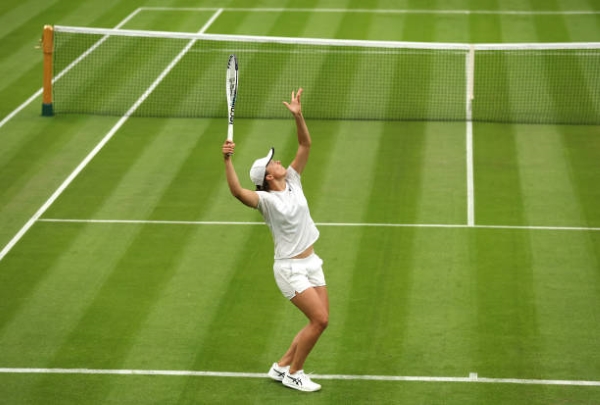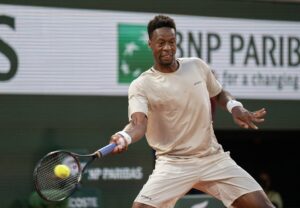Iga Swiatek is the player of the moment in women’s tennis. A two-time French Open champion, , Swiatek equalled Venus Williams’ record of 35 straight wins. By the time you read this; that will probably have extended. What makes Swiatek such a dominant player? Let’s take a look at her game.
Iga Swiatek: An In-Depth Look At Her Game
Prologue
It has been an incredible 2022 so far. The year didn’t start in particularly rousing fashion, but things changed dramatically for the Pole around March. That was the moment when Ashleigh Barty announced her shock retirement from tennis and relinquished the #1 position. Swiatek took the world #1 ranking and she has not looked back. In so doing, dominating the hard courts in North America and clay courts in Europe. Swiatek’s next task is to dominate the grass courts in England; this may not be as straightforward, particularly as she will arrive at Wimbledon without having played a grass-court match in 2022.
Serve
Swiatek’s serve is solid, without quite being a weapon in its own right. This is mainly due to the height she gets off the bounce (kick) but it is not an express delivery. Swiatek comes in at 1 metre 76 cm (5 ft 9 inches). It’s a good height for a top female player, the same height as Serena Williams, Amelie Mauresmo and Steffi Graf. It has served her well in this win streak (pardon the pun) allowing her to dominate players. What is impressive is the thought process behind it, concentrating on patterns as opposed to outright pace.
For instance during the clay season, Swiatek would kick the ball high to the opponents’ backhand on the ad court. This often results in a short reply which allows her to hit the forehand down the line for a winner. This is by design, and requires very good footwork.
Swiatek also likes to hit the kicker on the deuce court and equally adept at the slice serve to the forehand. In the French Open final against Coco Gauff, she hit an ace to the American’s forehand wing which kicked above Gauff’s shoulder. This is unusual in women’s tennis. Swiatek has a good ball toss, mainly above her head or very slightly left. Her serve does look slightly clunky, but it does the job well. That said, the slightly unnatural motion could explain why she does not serve at express pace.
So far in 2022 Swiatek has a first serve percentage of 64%. She has won 67% of those serves she gets into play and hit 78 aces to date. Swiatek has won 51% of the points behind her second serve, but has also served 90 double faults. Those numbers have seen Swiatek win 76% of her service games this year. Her first serve percentage is good at 64% and the points won behind her second serve is not bad. But she has also served more double faults than aces. One might expect the world #1 to have a higher percentage behind her second serves, 51% is a little bit on the lower side.
It could be with her newfound status as #1 Swiatek’s numbers will improve over the next 12 to 24 months. At the moment, the kicker serve is keeping opponents at bay. Perhaps when opponents return that better, Swiatek will have to think about using a flatter serve more often to keep them guessing. In fact, it would be no surprise to her make that adjustment over the course of the upcoming grass season.
Return of Serve
Swiatek showed throughout the 2022 French Open that she has a very aggressive return of serve. In the spirit of players like Venus and Serena Williams, as well as Maria Sharapova. Swiatek likes to take the ball early and hammer it back as hard as she can. In the final against Gauff, she was at home placing it cross court as well as down the line for winners. It was impressive and I expect that to be a weapon throughout her career.
As the season has progressed Swiatek has compiled a record of 51% of return points won and 55% of return games won. Swiatek has also converted 54% of her break point opportunities. These are excellent figures and is probably more an indicator of her current title as the dominant figure on the WTA Tour. Overall, Swiatek has shown herself to be a very aggressive player from the baseline. The rallies are short and the points are quick. It will be interesting to see how she does on grass moving forward, considering she is a former junior Wimbledon champion. Swiatek is yet to have a proper go on the surface, an ideal situation this year to see how she goes.
Forehand
Swiatek’s forehand is her greatest strength. During the French Open she used it to dominate her opponents to great effect. This looks set to continue well into this season and beyond. We have to remember Swiatek is still a very young player, and initially there were discussions about the forehand. However, this year this shot has come on well and both technique and tactics are impressive. Swiatek uses a western grip, which is an extreme version of the forehand grip but she hits through the ball well enough that it’s hard to notice.
In the past many top players with western grips had issues generating pace with too much loop. Swiatek has the power with a lot of spin but not too loopy at all. An important component part of that is the sort of tennis she wants to play. Swiatek has put together tactics that is more at home on the ATP Tour than WTA tour. The vast majority of WTA players adopt a more open stance forehand and let the ball come onto them. They often stoop to muscle the ball from a neutral position, whereas Swiatek stays slightly left of the centre line. This allows her to adopt a semi-open stance.
This in turn makes it easier to hit inside out forehands cross court and inside in forehands down the line. This immediately takes her game to the next level. I have never quite understood why more WTA players have not learned off the guys and taken this approach. This has been a staple tactic of top male players since the mid 1980s. Borg did this with a wood racquet in the 1970s. There are great players like Steffi Graf who approached their forehands in this manner but not a large number. Barty used that approach before her sudden retirement. WTA players have shown they are not able to deal with Swiatek collectively. Something coaches will need to look at to figure out how to counter Swiatek.
In the past, players like Amelie Mauresmo who used an extreme grip, brushed up the ball and often dropped it short. Mainly because Mauresmo hit too often off the back foot. Andy Murray had a similar problem. It is refreshing to watch Swiatek play with an extreme grip but hit off her front foot. Always looking to hurt opponents instead of being on the defensive.
Backhand
In line with most modern WTA players, the backhand is a very reliable shot. Reliable in the sense that it will not break down under pressure. This thought process by coaches has led to the complete demise of the single hand backhand in women’s tennis. Coaches want their players to win at an early age and the two hander is the quickest way to teach the shot. Interestingly, however, there is a video of Swiatek from 2020 practising a one hand backhand and the stroke looked good.
As on the forehand side, Swiatek is looking to keep the rallies fairly short, preferring 10 shots and under. This makes her ultra aggressive at all times. Consequently, Swiatek has not had to do a lot of defending. We have not seen the backhand under pressure this year. There are a few ways to test it. The first is to hit kick serves to her backhand around shoulder height. The second is to stretch her and get it away from the forehand strike zone.
This is more difficult than it appears because of her position on the court. Another method is to hit the backhand down the line to Swiatek’s forehand, then open up the backhand side. This would make her stretch but again, this has not proven straightforward so far. Barty had the best slice backhand in the business and used it well against Swiatek in past matches. As Mats Wilander showed in the late 1980s, Swiatek can acquire the slice backhand as her career develops to give her more options.
Volleys and Overheads
During the 2022 French Open, Swiatek was not a regular visitor to the net. Her groundstrokes did so much damage, there was often not much need to venture to net to finish points. We did see some smashes on a number of occasions so Swiatek is not afraid to venture forward. All #1 players who want to stay there have to brush up on the forecourt and transition game. It will be tough to win and win just from the baseline on all surfaces. Theoretically, the extreme western grip shouldn’t be a problem when volleying. Indeed, Mauresmo had a very western forehand grip and was probably the best volleyer since Martina Navratilova.
Movement
This is an area of Swiatek’s game which is clearly at an elite level. The best players make it look easy to the point of not noticing. The only way Swiatek can play with a semi-open stance in the backhand corner is due to the fact she trusts her movement out wide to cover the forehand side. What we will find out during the grass season is how good her movement is. In terms of coming forward or brought in by her opponent. As Swiatek won the girls’ singles at Wimbledon in 2018, it should be an indicator she won’t have too many problems there. A good clay-court game often translates to a good hard-court game. Swiatek’s priority will be to win the US Open or the Australian Open, to validate her dominance.
The Mind Game
It is reported (mainly by her own admission) that Swiatek is an emotional player. She has been channelling this well and getting stronger in this department. Swiatek travels with a psychologist, a new development in professional tennis; they are usually in the background.
Summary
Dissecting Iga Swiatek’s game shows that we are looking at a player who will be top 10 for some time. How much of that time is spent as number 1 remains to be seen. Swiatek has all of the tools to become a legend of the game, injury and loss of form permitting. A few rivals could spring up to challenge her. If that happens, that should improve her game even further. A great future beckons.
Main photo:
Embed from Getty Images






